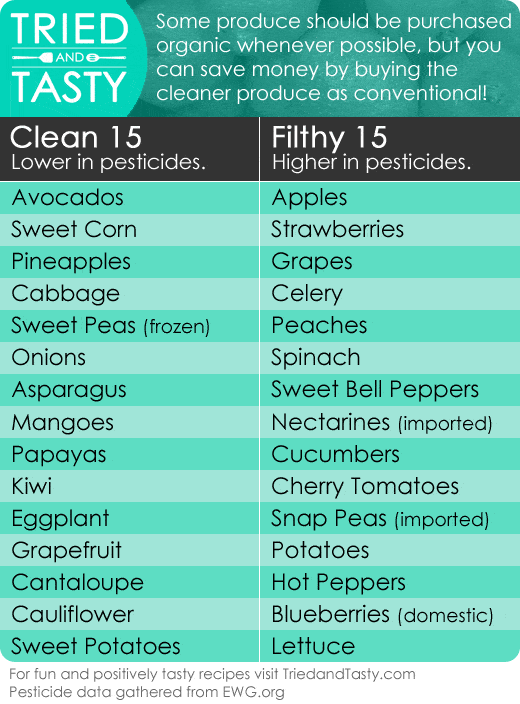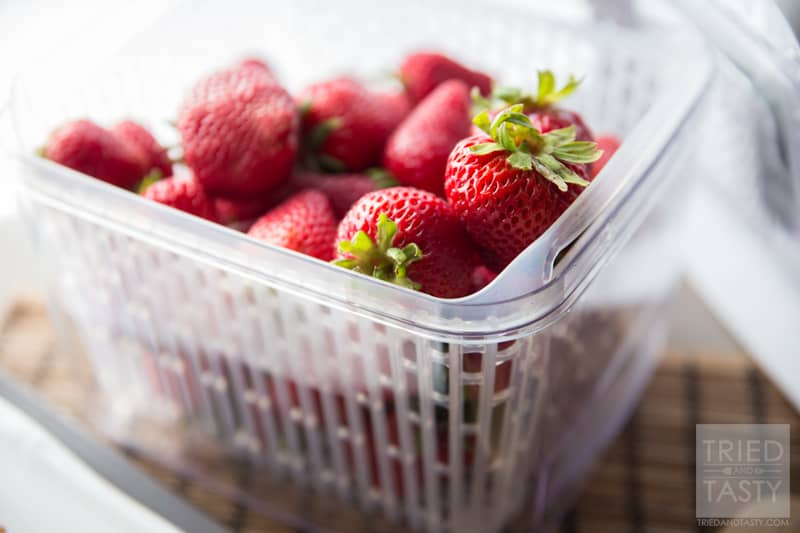
Click HERE to download your FREE printable!
Why Buying Organic Produce is Important:
[Insert another guest post from the expert, my husband!]
I’m afraid I’ve got some bad news…
Did you know that up to 47 different pesticide residues can be found in conventionally (non-organic) grown apples? Or that up to 45 different pesticide residues can be found in conventionally grown strawberries? Would you ever guess that up to a whopping 52 different pesticide residues can be found in conventionally grown lettuce? You can visit whatsonmyfood.org for more details, including what issues these pesticides are known to cause.
Apples, strawberries, and lettuce are members of a not so desirable club which I’ve dubbed “The Filthy 15”, which consists of the fifteen conventionally grown fruits and vegetables that contain the largest amount of pesticide residues.
If you’re like me, you probably find it pretty frustrating that eating traditionally healthy foods can come with so much unwanted baggage!
Ready for the good news? There are also fifteen conventionally grown fruits and vegetables that either don’t require or don’t absorb nearly as much pesticide as “Filthy 15” produce. This produce has membership in a more desirable club titled “The Clean 15”. Take the Avacado for example – the cleanest member of ‘The Clean 15’ – it has been found to contain just 1 pesticide residue! Lettuce must be so green with envy right now (bad pun fully intended)! I put together this list using data provided by the Environmental Working Group and am extremely thankful for all the research that they do.
By making fruits and vegetables from ‘The Clean 15’ the bulk of the produce that you eat and by buying any fruits and vegetables from ‘The Filthy 15’ as organically grown rather than conventionally grown you can dramatically reduce your pesticide exposure while keeping costs reasonable.
Here’s something else to help with the sticker shock that can come from buying organic produce (which on average is about 1.5-2x as expensive as conventionally grown produce). Not only is it much lower in pesticides, but it’s also significantly higher in nutrients! The British Journal of Nutrition reviewed 343 studies on the topic and concluded that there was indisputable evidence that organically grown produce does in fact contain more nutrients than conventionally grown produce (see this LA Times article for more information on this study).
Still not convinced that organic produce is worth the extra money? The Journal of Applied Nutrition (1993; 45:35-39) conducted a study lasting two years in which they compared organically grown apples, potatoes, pears, wheat, and sweet corn to their conventionally grown counterparts and found “the organically grown food averaged 63% higher in calcium, 78% higher in chromium, 73% higher in iron, 118% higher in magnesium, 178% higher in molybdenum, 91% higher in phosphorus, 125% higher in potassium and 60% higher in zinc. The organically raised food averaged 29% lower in mercury than the conventionally raised food.” (see OrganicConsumers.org for more information)
Based on the data from that study, you’d essentially have to eat TWICE as much conventional produce as organic produce to get the same amount of nutrients. In my mind, that alone cancels out the price difference between conventionally grown and organically grown produce. The fact that you’d be consuming MUCH higher levels of pesticide residues from conventionally grown produce (especially if you’re eating twice as much of it to compensate for it’s decreased levels of nutrients compared to organic produce) just seals the deal for me.
But wait, there’s more! Organic farming practices are also typically better for the environment. Not only are far fewer pesticides used, but crops are generally grown in more sustainable ways that are easier on the land and don’t deplete soil nutrients nearly as much. One key thing to keep in mind is that the produce that you buy is only as good as the soil it was grown in. If the soil the produce was grown in was lacking in nutrients (from over-farming the land for example) then the produce itself will also be lacking in nutrients. Produce can’t absorb and deliver nutrients that weren’t in the soil in the first place.
STILL not convinced? By buying organic, it’s also more likely that you’ll be supporting smaller family run farms rather than feeding some all consuming faceless corporation. Granted, large corporations are increasingly buying up organic operations because they see the profitability and the demand that is present in the organic market – but the odds of your dollar landing in the pockets of a smaller, more local business are still greater when buying organic vs. buying conventional. This is especially true if you shop at your local farmers market.
So there you have it! I encourage you to print out the list of ‘Clean 15 vs. Filthy 15‘ produce from this page so that you can make wiser, healthier choices the next time you’re at the market. Here’s to your health!


Sarah Yannetta
Love love this!! Thank you for sharing! I will definitely bring this along on my next shopping trip!
Yvonne
Yay! Glad you came over to check it out! It’s so handy – you’ll love it!